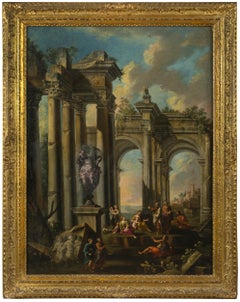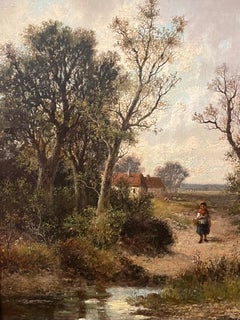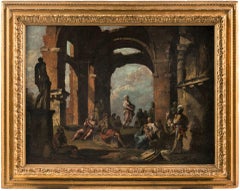Giovanni Paolo Panini Art
to
1
Overall Width
to
Overall Height
to
1
1
1
1
1
1
1
1
1
1
8,900
2,810
1,331
1,324
1
Artist: Giovanni Paolo Panini
An Architectural Capriccio with the Preaching of an Apostle
By Giovanni Paolo Panini
Located in New York, NY
Provenance: Santambrogio Antichità, Milan; sold, 2007 to:
Filippo Pernisa, Milan; by whom sold, 2010, to:
Private Collection, Melide, Switzerland
De Primi Fine Art, Lugano, Switzerland; from whom acquired, 2011 by:
Private Collection, Connecticut (2011-present)
Literature: Ferdinando Arisi, “Ancora sui dipinti giovanili del Panini,” Strenna Piacentina (Piacenza, 2009): pp. 48, 57, 65, fig. 31, as by Panini
Ferdinando Arisi, “Panini o Ghisolfi o Carlieri? A proposito dei dipinti giovanili,” Strenna Piacentina, (Piacenza, 2010), pp. 100, 105, 116, fig. 101, as an early work by Panini, a variant of Panini’s painting in the Museo Cristiano, Esztergom, Hungary.
This architectural capriccio is one of the earliest paintings by Giovanni Paolo Panini, the preeminent painter of vedute and capricci in 18th-century Rome. The attribution to Panini has been endorsed by Ferdinando Arisi, and a recent cleaning of the painting revealed the artist’s signature in the lower right. Like many of his fellow painters working in Rome during his day, Panini was not a native of the Eternal City. He first trained as a painter and stage designer in his hometown of Piacenza and moved to Rome at the age of 20 in November 1711 to study figure painting. Panini joined the workshop of Benedetto Luti (1666-1724) and from 1712 was living on the Piazza Farnese. Panini, like many before and after him, was spellbound by Rome and its classical past. He remained in the city for the rest of his career, specializing in depicting Rome’s most important monuments, as well as creating picturesque scenes like this one that evoked the city’s ancient splendor.
The 18th century art historian Lione Pascoli, who likely knew Panini personally, records in his 1730 biography of the artist that when Panini came to Rome, he was already “an excellent master and a distinguished painter of perspective, landscape, and architecture.” Panini’s earliest works from this period still show the evidence of his artistic formation in Piacenza, especially the influence of the view painter Giovanni Ghisolfi (1623-1683). However, they were also clearly shaped by his contact in Rome with the architectural capricci of Alberto Carlieri...
Category
18th Century Old Masters Giovanni Paolo Panini Art
Materials
Canvas, Oil
Related Items
Landscape Near Felday, Surrey
By Abraham Hulk the Younger
Located in Hillsborough, NC
Dutch/English artist Abraham Hulk the Younger (1851-1922) is most known for landscapes of the British countryside. This work is one of a pair (the second work is also available by s...
Category
Late 19th Century Old Masters Giovanni Paolo Panini Art
Materials
Canvas, Oil
$2,240 Sale Price
20% Off
H 27 in W 22.75 in D 2.13 in
Religious Italian painter - 18th century figure painting - Saint Monica
Located in Varmo, IT
Italian painter (18th century) - Saint Monica in prayer.
56 x 32 cm.
Antique oil painting on canvas, without frame (not signed).
Condition report: Good state of conservation of th...
Category
Mid-18th Century Old Masters Giovanni Paolo Panini Art
Materials
Oil, Canvas
$956 Sale Price
55% Off
H 22.05 in W 12.6 in
Large 17th century Italian old master - Noli me tangere, Christ in the garden
By Pier Francesco Cittadini
Located in Aartselaar, BE
Large 17th Century Italian Old Master, The Garden - Noli me tangere, Pier Francesco Cittadini (attr.)
Description
In the stillness of a garden in bloom, Noli me tangere captures a p...
Category
17th Century Old Masters Giovanni Paolo Panini Art
Materials
Canvas, Oil
$7,773
H 31.89 in W 40.56 in
17th century follower of Rubens, two military men on horse back in a landscape
Located in Woodbury, CT
17th century English/Dutch School, from the Circle of Sir Peter Paul Rubens
A very interesting and well-painted 17th-century oil on canvas of two men seated on horseback in a landsc...
Category
1680s Old Masters Giovanni Paolo Panini Art
Materials
Canvas, Oil
$8,050 Sale Price
30% Off
H 16 in W 22 in
17th century Italian school, The Virgin and Child with Saint John the Baptist
Located in PARIS, FR
17th century Italian School
The Virgin and Child with Saint John the Baptist
Oil on canvas
Dimensions: h. 106 cm, l. 77 cm
Important 17th century Italian carved giltwood frame
Fram...
Category
17th Century Old Masters Giovanni Paolo Panini Art
Materials
Canvas, Oil
$25,472
H 53.54 in W 42.13 in
Lamentation of Christ oil on paper laid on canvas
By Annibale Carracci
Located in New York, NY
The composition repeats that of a large altarpiece designed by Annibale Carracci for the church of San Francesco a Ripa, Rome (now in the Louvre, Par...
Category
Early 17th Century Old Masters Giovanni Paolo Panini Art
Materials
Canvas, Paper, Oil
$4,500 Sale Price
25% Off
H 9.85 in W 6.89 in
Antique Italian painter - 18th century figure painting
Located in Varmo, IT
Italian painter (18th century) - Chrono.
90.5 x 106 cm.
Antique oil painting on canvas, without frame (not signed).
Condition report: Lined canvas. Good state of conservation of t...
Category
Early 18th Century Old Masters Giovanni Paolo Panini Art
Materials
Canvas, Oil
$4,783 Sale Price
20% Off
H 35.63 in W 41.74 in
17th Century By Mondino Mystic Marriage of St Catherine of Alexandria Oil/Canvas
Located in Milano, Lombardia
Antonio Mondino (information from c. 1610 to c. 1626)
Title: Mystic Marriage of St Catherine of Alexandria
Medium: Oil on canvas
Dimensions:...
Category
17th Century Old Masters Giovanni Paolo Panini Art
Materials
Oil, Canvas
$47,835 Sale Price
20% Off
H 34.45 in W 39.38 in D 1.97 in
17th Century by Mexican Maestro Virgin of Solitude Oil on Canvas
Located in Milano, Lombardia
17th Century Mexican Maestro
Title: Virgin of Solitude
Medium: Oil on canvas
Dimensions: without frame 165 x 123 cm - with frame 194 x 152 cm
Bla...
Category
17th Century Old Masters Giovanni Paolo Panini Art
Materials
Canvas, Oil
$29,658 Sale Price
20% Off
H 64.97 in W 48.43 in
Perseus and Andromeda
Located in Paris, Île-de-France
Carle Vanloo (Nice 1705 – Paris 1765)
Perseus and Andromeda
Oil on canvas. H. 081; W. 065.
Alongside François Boucher (1703-1770) and Charles-Joseph Natoire (1700-1777), Carle Vanlo...
Category
1720s Old Masters Giovanni Paolo Panini Art
Materials
Oil, Canvas
18th century French Old Master Portrait of a woman in oriental costume
Located in Aartselaar, BE
French 18th century old master portrait of a majestic lady dressed "à la Turque"
The sitter at the viewer with a kind and enigmatic smile and twinkling eyes. She looks elegant and kind, yet also has an intelligent and determined aura, reflecting the character of someone who is in charge of her own life and destiny.
De Silvestre paid great attention to her spectacular outfit, which is striking in its portrayal of the sumptuous fabrics and their decorative richness. She is wearing a luxurious royal blue robe à la...
Category
1740s Old Masters Giovanni Paolo Panini Art
Materials
Canvas, Oil
$22,124
H 31.89 in W 25.6 in D 0.4 in
18th century allegorical painting of The Triumph of Beauty
Located in London, GB
Exhibited:
London, Royal Academy, 1800, no. 93
What was happening in British history painting in around 1800? In recent discussions of the emergence of a British School of history painting following the foundation of the Royal Academy in 1768, this is a question which is rarely posed and one which is not easily answered. Examination of surviving Royal Academy exhibition catalogues reveals a profusion of artists’ names and titles, few of which remain immediately recognizable, whilst endeavours to explain the impact of exhibition culture on painting - such as the 2001 Courtauld show Art on the Line - have tended to focus on the first and second generation of Royal Academician, rather than young or aspiring artists in the early nineteenth century. This makes the discovery and identification of the work under discussion of exceptional importance in making sense of currents in English painting around 1800. Executed by Edward Dayes...
Category
18th Century Old Masters Giovanni Paolo Panini Art
Materials
Canvas, Oil
$248,282
H 50 in W 36 in
Previously Available Items
18th century Italian landscape figures painting - Pannini Oil on canvas panini
By Giovanni Paolo Panini
Located in Varmo, IT
Giovanni Paolo Pannini (Piacenza 1691 - Rome 1765) - "Preach a sibyl under an architectural portico and a statue of Hercules".
53 x 72 cm without frame, 71 x 89 cm with frame.
Oil ...
Category
Early 18th Century Rococo Giovanni Paolo Panini Art
Materials
Canvas, Oil
Giovanni Paolo Panini art for sale on 1stDibs.
Find a wide variety of authentic Giovanni Paolo Panini art available for sale on 1stDibs. You can also browse by medium to find art by Giovanni Paolo Panini in canvas, fabric, oil paint and more. Much of the original work by this artist or collective was created during the 18th century and is mostly associated with the Old Masters style. Not every interior allows for large Giovanni Paolo Panini art, so small editions measuring 29 inches across are available. Customers who are interested in this artist might also find the work of Sir Godfrey Kneller, Jan Frans van Bloemen (Orizzonte), and George Morland. Giovanni Paolo Panini art prices can differ depending upon medium, time period and other attributes. On 1stDibs, the price for these items starts at $85,000 and tops out at $85,000, while the average work can sell for $85,000.



